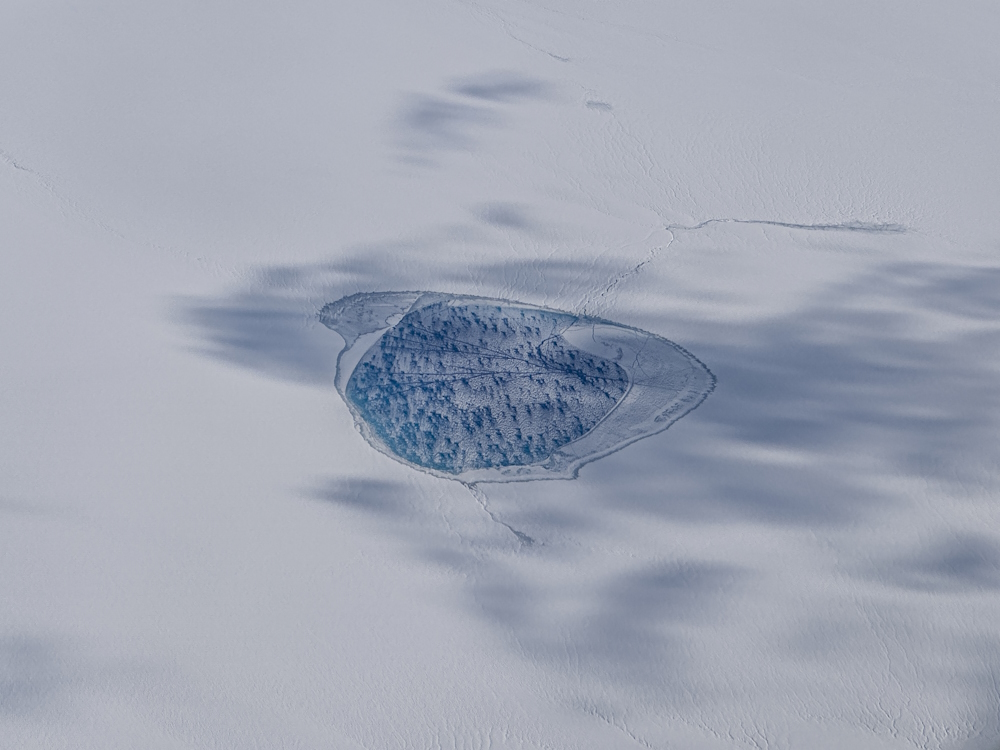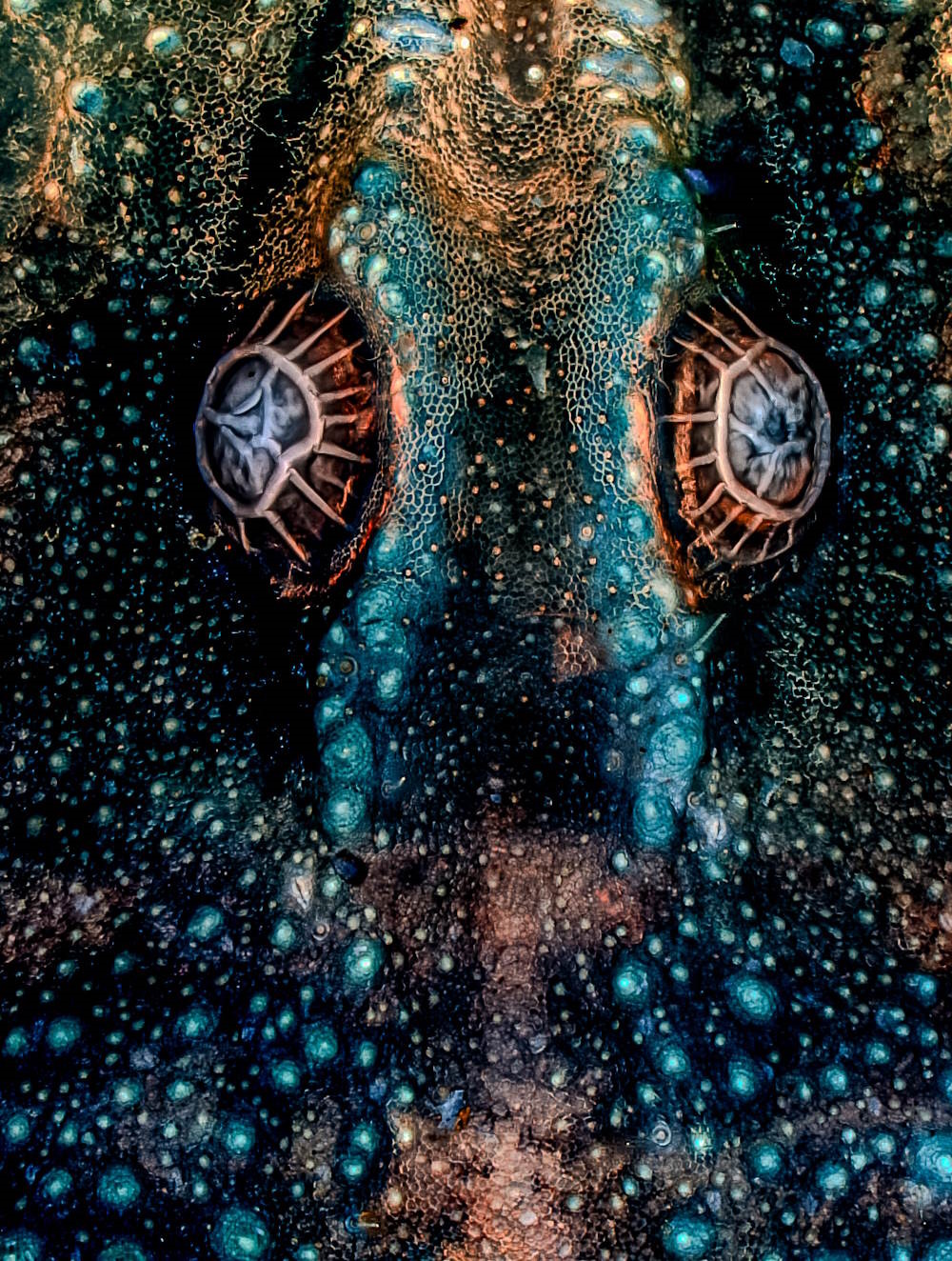Finalists 2024
In 2024 we asked scientists from around the world to send us their images representing the areas of Astronomy, Behaviour, Earth Science and Climatology, Ecology and Environmental Science, and Microimaging. Our winners and runners-up can be found below.
We are grateful to our judges Professor Jon Blundy FRS, Professor Duncan Mackay, Professor Ulrike Muller and Hugh Turvey (Science Chair of the Royal Photographic Society) for identifying the sharks, ice caps, galaxies and scorpion eyes that became our finalists.

Competition winner 'The hunt from above' by Angela Albi. Drone pilot, August Paula. One of the main reasons animals group together is to avoid predators. In this case, a large school of hardyhead silversides faces four juvenile blacktip reef sharks, which occasionally attack, causing the fish to respond collectively. Blacktip reef sharks are a social species and as juveniles, they often gather in schools of fish near the shore in the Maldives, where they circle within the school. For my postdoctoral research, I study the interactions between blacktip reef sharks and baitfish schools in the Maldives. I use drones to capture behavior from above, focusing on whether the sharks coordinate during their hunts or how they interact with other species. This photo is a frame from our study drone footage, post-processed for contrast, exposure, and white balance.

Astronomy winner 'Heart and Soul' by Imran Sultan. The Heart and Soul are two magical nebulae found in the Cassiopeia constellation. To capture their intricacies, I shot nearly 14 hours of photos of the faint nebulae (over three nights in fall 2023), the longest I have ever photographed a target. The Heart and Soul are illuminated by emission from the ionized gas in the star-forming region, shown here in the HOO color palette. I used a special filter which only allows specific wavelengths of light to pass through (specifically, the wavelengths corresponding to H-alpha and O-iii emission, which are commonly emitted by the gas in emission nebulae. Equipment: ZWO ASI533MCPro: 164x300 sec light; flat/bias/dark frames. Optolong L-Ultimate filter.

Earth science and climatology winner 'Ice cap melt lake in Greenland' by David Garcia. The photo depicts a supraglacial melting lake over the Greenlandic ice sheet, ranging from some meters to several kilometres wide. Increasing in numbers due to climate change, they can suddenly drain if a crack in the ice appears, hydrofracturing, collecting water at the bottom of the lubricating the glacier and speeding its flow towards the ocean. Greenland's ice sheet is the second largest ice mass in our planet, and its melting would raise the sea level approximately 7 meters. Taken during a flight from Kangerlussuaq to Ilulissat, when a small window of light appeared, it was singular due to hundreds of small aquamarine structures formed by melting and thawing process. Although some clouds cast shadows over the lake, I was elated to have captured the image.

Ecology and environmental science winner 'Secretary bird gullet' by Peter Hudson. Secretary birds are closely related to falcons but have evolved a stork like mode of life, where they stalk around the savannah and feed on locusts, lizards and amphibians by punching them on the ground. This bird has just caught a locust, and as it swallows its prey it synchronously closes its third eyelid, the nictatating membrane, across its eye to protect their eye from damage. ISO 100, 1/2000s at f4.5.

Microimaging winner 'Tired eyes' by Jose Manuel Martinez Lopez. These are the eyes of a scorpion observed in fluorescence under the microscope with an objective of 10x/0.3. The image is a focus stacking from 110 images and shows an area of 1.4 x 1.05 millimeters.

Astronomy runner-up 'The beauty of our Milky Way' by Mohamed Aboushelib. The image of a galactic core of the Milky Way was taken from the Kottamia Astronomical Observatory in Egypt. I went away from city lights to take advantage of the dark sky to record this beauty of the summer sky. It took me three nights to take hundreds of photos and stacked them together choosing the best photos with a total exposure of more than five hours. All photos were tracked using a star tracker to be able to take long exposure photos. The raw photo had to go through some edits using Adobe Photoshop to show the details and colors of the Milky Way.

Behaviour runner-up 'Breeding frenzy' by Ovidiu Dragan. The photo captures an underwater scene of a European toad (Bufo bufo) breeding frenzy, where these toads gather in large numbers in shallow waters during the breeding season. Taken this spring while my research team and I were collecting toad eggs for experiments. The area was filled with toads, all desperately trying to mate with anything they could find . An intriguing aspect of this photo, though less apparent, is that the second toad on top is a male European green toad (Bufotes viridis), not a European toad. This green toad was attempting to mate with a different species, which they coexist with in their native area. This behavior in a mountainous region surprised us. The photo was taken with a phone camera and, despite some basic adjustments and a vignette effect, I think it turned out quite well.

Ecology and environmental science runner-up 'The Piscean Mad-Eye-Moody!' by Abhijeet Bayani. For my undergraduate course in Ecology, I took students out in intertidal zone on the Indian western coast. While teaching sampling, we found something my students hadn’t seen before. I had accidentally unearthed a live flatfish! "This is not possible, it has to be a mutation!" exclaimed a student seeing its asymmetric eyes. It's flat because it is a benthic species, but why the eyes are so weird? Here comes the Evo-Devo! Interestingly, they are born symmetric, but during this sinistral metamorphosis its right eye moves to the left. In my opinion, this observation is also important as it evidently disproves a pseudoscientific notion of evolution called 'intelligent design'. If it were a perfect and intelligent design, why would one eye be situated so odd in this species? I loved our Piscean Mad-Eye Moody for being odd yet loyal to science of evolution. Camera settings: f13, 1/200s, ISO800, Nikon Z50.

Microimaging runner-up 'The Lovecraftian World' by Irina Petrova Adamatzky. In this photograph, the mycelium of Armillaria sprawls across the surface, forming a pattern reminiscent of a Lovecraftian world map. The intricate, web-like structures of the mycelium are artfully illuminated by five strategically placed LED lights, casting an eerie glow and dramatic shadows that accentuate its otherworldly appearance. This striking sample was meticulously grown at the R&D department of Technische Universität München and then sent to UWE, School of Computing and Creative Technologies for photography. To capture the full depth and complexity of this fascinating subject, focus stacking was employed. This technique involves taking multiple shots at different focus distances and then combining them to create a single image with an extended depth of field. The resulting image highlights not only the biological beauty and complexity of fungal growth but also the scientific phenomena of mycelial networks, showcasing their ability to spread and intertwine in intricate, expansive patterns.
